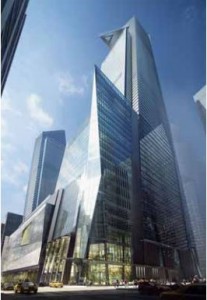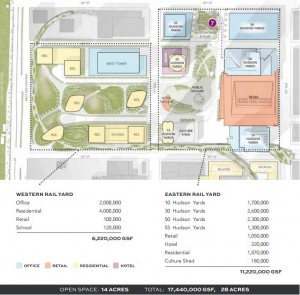Share This
Related Posts
Tags
Hudson Yards
By Yardi Blog Staff on Sep 5, 2014 in News
New York City’s Hudson Yards marks the beginning of a new era in urban design. Developed by Related Companies and Oxford Properties Group on the West Side of Manhattan, the $20 billion project is being touted as the largest private real estate development in the U.S. history and a model of responsible development.
Everything about Hudson Yards is impressive; from the massively heavy, incredibly strong platforms that will serve as a foundation for the premier district, to the innovative infrastructure systems and state-of-the-art buildings that will redefine the area’s vibe and skyline.
But what’s fascinating about Hudson Yards are not just its grandeur and advanced engineering. The mega-development puts people first; it promises to build a nurturing environment with emphasis on livability, sustainability and occupant well-being. To accomplish this, the developers have launched a series of interactive programs, including the “Quantified Community” project, a joint venture with New York University’s Center for Urban Science and Progress (CUSP).
The partnership aims to create the nation’s first “Quantified Community” – a fully-instrumented urban neighborhood that will measure and analyze key physical and environmental attributes at Hudson Yards. With this new project, Related and Oxford seek to deliver an enhanced experience for both tenants and residents while improving operational efficiencies and productivity at the complex.
“The ability to conceive of and develop an entirely new neighborhood creates tremendous opportunities. Hudson Yards will be the most connected, measured, and technologically advanced digital district in t he nation,” said Jay Cross, President of Related Hudson Yards.
he nation,” said Jay Cross, President of Related Hudson Yards.
“Our cutting-edge commercial tenants are drawn to Hudson Yards for its state-of-the-art infrastructure featuring unprecedented wired, wireless, broadband, and satellite connectivity; and energy optimization through on-site power generation and central waste systems. Through our partnership with CUSP we will harness big data to continually innovate, optimize and enhance the employee, resident, and visitor experience,” he added.
And it does not stop at that. CUSP plans to take the initiative one step further by translating collected data into trends and use the information to help not only New York City but cities across the globe become more productive, livable, equitable, and resilient.
“The Quantified Community will create a unique experimental environment that provides a testing ground for new physical and informatics technologies and analytics capabilities, which will allow for unprecedented studies in urban engineering, urban systems operation, and planning, and the social sciences,” explained Dr. Constantine Kontokosta, PE, Deputy Director & Head of the Quantified Community initiative at CUSP. “Given the scale and significance of Hudson Yards, we believe that our partnership with Related will help to create a model for future sustainable, data-driven urban development.”
Whereas the final parameters to be measured in Hudson Yards are still under discussion, the partnership released the following examples:
- Measuring, modeling, and predicting pedestrian flows through traffic and transit points, open spaces, and retail space.
- Gauging air quality both within buildings and across the open spaces and surrounding areas.
- Measuring health and activity levels of residents and workers using a custom-designed, opt-in mobile application.
- Measuring and benchmarking solid waste with particular focus on increasing the recovery of recyclables and organic (i.e. food) waste.
- Measuring and modeling of energy production and usage throughout the project, including optimization of on-site cogeneration plant and thermal microgrid.
“This partnership between Hudson Yards and CUSP is successful because Related and Oxford understand the importance of sensor-enriched environments in creating the most efficient and livable cities of the future,” commented Dr. Steven Koonin, Director of CUSP. “CUSP aims to be a leader and innovator in the emerging field of ‘Urban Informatics’ – the observation, analysis, and modeling of cities – and our first Quantified Community at Hudson Yards is a great step toward this goal. CUSP is extremely grateful for this partnership and we look forward to working with them as this project continues to take shape.”
 At full build-out, the Hudson Yards development will include approximately 17 million square feet of commercial and residential space, more than 100 shops and restaurants, approximately 5,000 residences, Culture Shed, 14-acres of public open space, a 750-seat public school and a 150-room luxury hotel – all precisely calibrated to meet the needs of residents, employees and visitors alike.
At full build-out, the Hudson Yards development will include approximately 17 million square feet of commercial and residential space, more than 100 shops and restaurants, approximately 5,000 residences, Culture Shed, 14-acres of public open space, a 750-seat public school and a 150-room luxury hotel – all precisely calibrated to meet the needs of residents, employees and visitors alike.
In order to complete the 28-acre project, two “platforms” need to be constructed to bridge over 30 active Long Island Rail Road (LIRR) train tracks, three subsurface rail tunnels utilized by Amtrak and New Jersey Transit, and a fourth passageway, the Gateway tunnel, currently under construction. The finished buildings will extend through the platform and rise above. The platforms will cover approximately three quarters of the Eastern and Western Rail Yards.
Construction is currently underway on the Eastern Platform at Hudson Yards, which will eventually feature two soaring commercial towers, more than 100 shops and restaurants, luxury and affordable residences, a boutique hotel, a unique cultural space and over six acres of open space. 10 Hudson Yards, a 1.7-million-square-foot tower that will provide first-class office space for Coach Inc., L’Oreal USA, SAP and Fairway Market, is slated for occupancy in 2015. The entire Eastern Rail Yards, including 30 Hudson Yards, home to Time Warner Inc., will be complete in 2018.
“The construction of the platform is the crucial step towards reimagining the West Side and connecting two of Manhattan’s most thriving neighborhoods – Chelsea and Hell’s Kitchen,” a spokesperson for Related told Commercial Property Executive.
Hudson Yards is expected to have a huge impact on the local economy, bringing both new jobs to the area and acting as a catalyst for new development.
According to Gary LaBarbera, President of the Building and Construction Trades Council of Greater New York, “over the next decade, this landmark neighborhood development will create over 23,000 union construction jobs that come with the training to work safely and productively and the good wages, health insurance and retirement security that are essential to middle class opportunity. Our affiliated unions and members are proud to partner with Related and Oxford on a project that will forever change the west side of Manhattan and demonstrate what responsible development looks like.”
Upon completion, more than 40,000 people a day will either work in or call Hudson Yards their home. Additionally, it is anticipated that more than 24 million people will visit Hudson Yards every year.
The Hudson Yards project is set for completion in 2024.
